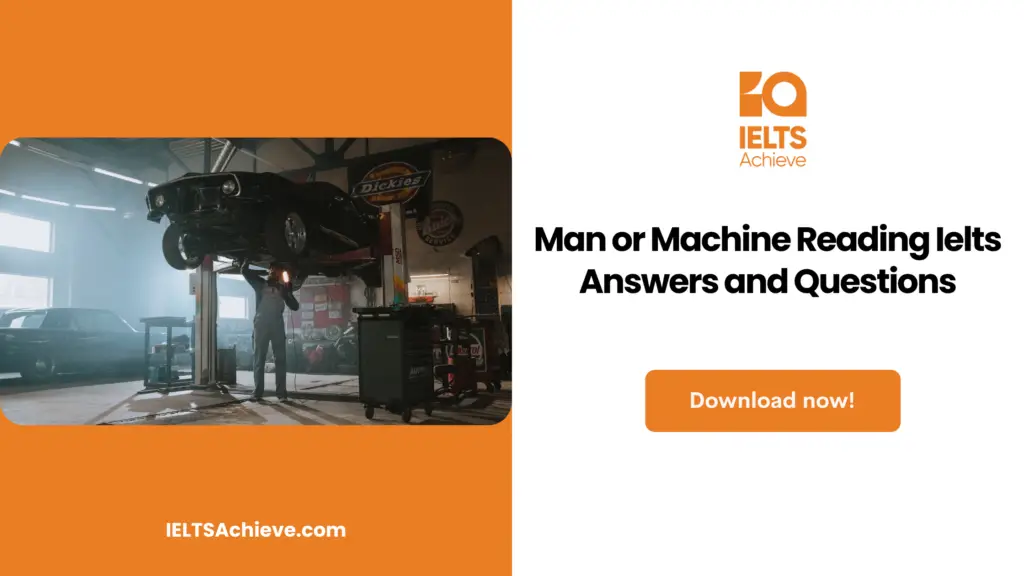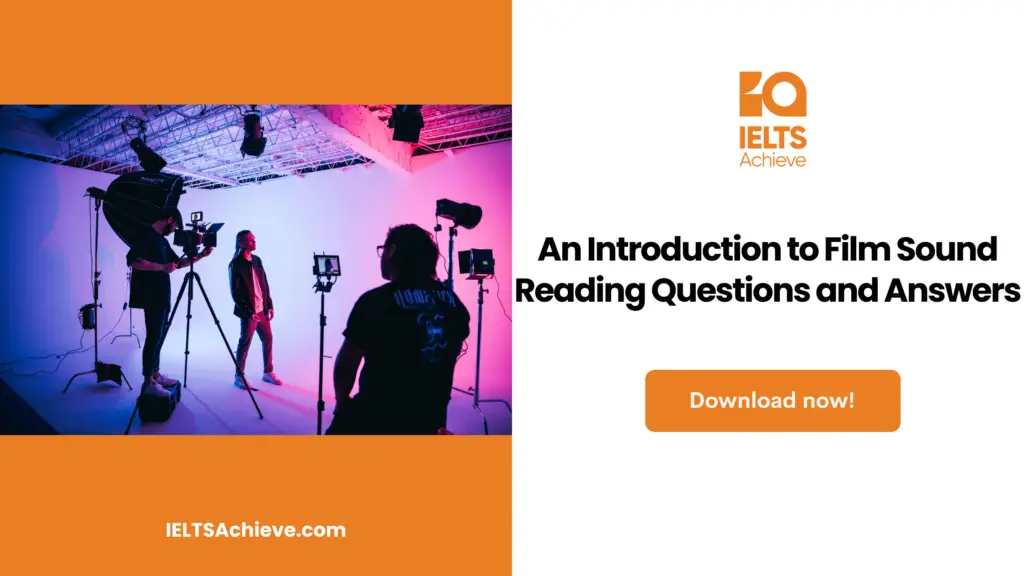The Blog post contains the following IELTS Reading Questions:
- IELTS reading locating information questions
- IELTS reading summary completion questions
- IELTS reading true false not given questions
Stay informed and prepared for success – Explore our comprehensive Reading Test Info page to get valuable insights, exam format details, and expert tips for mastering the IELTS Reading section.
Man or Machine Reading Passage

Man or Machine
A.
Honda’s ASIMO, called “the world’s most advanced human-looking robot,” was on display at the Museum of Science in Cambridge, Massachusetts, in July 2003. (the Advanced Step in Innovative Mobility). Honda’s creation is now touring North America, entertaining crowds everywhere it goes. After 17 years of development, ASIMO measures four feet in height, weighs around 115 pounds, and resembles a youngster in an astronaut’s outfit. Though it is difficult to recognize ASIMO’s face from a distance, it features a grin and two huge ‘eyes’ that hide cameras. The robot cannot function independently; its activities are “remotely directed” by scientists through the computer in its bag. However, witnessing AIMIO play at a performance in Massachusetts, it appeared preternaturally human. As ASIMO moved forward and backward, side to side, and up and down, the crowd applauded. Following the event, several individuals expressed their desire for robots to play a larger part in everyday life, with one even describing the robot as “another human.”
B.
While the Japanese have made significant progress in handling some of the technical issues associated with human dynamics and bipedal motions, scientists at MIT’s previous Artificial Intelligence (AI) lab (recently renamed the Computer Science and Artificial Intelligence Laboratory, CSAIL) have been developing robots that can behave and communicate with humans for the last ten years. Kismet, one of MIT’s robots, includes an anthropomorphic head with two eyes (complete with eyelids), ears, a mouth, and brows. It demonstrates numerous facial emotions, including pleased, sad, afraid, and disgusted. Human interlocutors can interpret some of the robot’s facial emotions and often adjust their conduct towards the machine as a consequence–for example, by playing with it when it appears sad. Kismet is currently at the MIT Art Gallery, but the concepts discovered here are being explored in future robots.
C.
Another ground-breaking endeavor from MIT’s previous AI lab is called “Cog” (short for “cognition”). Cog features a head, eyes, two arms, hands, and a torso, and its dimensions were derived from a researcher’s body in the lab. Cog’s work has been used to test notions of embodiment and developmental robotics, namely getting a robot to gain intelligence by reacting to its surroundings via sensors and learning through these sorts of interactions.
D.
MIT has made significant progress in developing engaging, human-like robots. Some scholars assert that despite ASIMO’s impressive technical accomplishments, it is not an intelligent machine since it cannot engage meaningfully and independently with the unpredictable elements of its environment and learn from its mistakes. Robots like Cog and Kismet, as well as new robots at MIT’s CSAIL and media lab, are starting to achieve this.
E.
These innovations are intriguing. It is an incredible accomplishment to create a machine that can walk, make gestures, and learn from its surroundings. And keep an eye on this space: these accomplishments are sure to be quickly surpassed. Autonomous robots might have a wide range of applications in society, freeing humans from routine duties. In Japan, for instance, the goal is to develop robots that can do jobs comparable to those of a typical person, as well as function in more complex scenarios such as firemen, astronauts, or medical assistance to the elderly in the workplace and at home–in part to counteract the impacts of an aging population.
F.
Such robots reveal a lot about how we see mankind, and they bring out the best and worst in us. On the one hand, these advancements demonstrate human creativity—our capacity to create, explore, and increase our influence over the environment. On the other hand, the desire to construct a humanoid robot is motivated by inhuman notions, such as the belief that human friendship can be replaced by machines, that people lose their humanity when interacting with technology, or that we are nothing more than surface and ceremonial behaviors, which can be mimicked with metal and electrical circuits.
Unlock your full potential in the IELTS Reading section – Visit our IELTS Reading Practice Question Answer page now!
Recommended Questions:
Renewable Energy IELTS Reading Question with Answer
Man or Machine reading questions
Question 1–6
Reading passage 1 has six paragraphs, A-F. Which paragraph contains the following information? Write the correct letters, A-F, in boxes 1-6 on your answer sheet. NB You may use any letter more than once.
1. Using robots in various ways.
2. A robot with proportions that are identical to those of an adult.
3. The capacity of robots to replicate humans and take their positions.
4. A comparison of ASIMO for Honda and other robots.
5. Advantages and disadvantages of robotics.
6. A robot with eyebrows.
Questions 7–11
Complete the following summary of the paragraphs of Reading Passage
1. Use NO MORE THAN TWO WORDS from the Reading Passage for each answer. Write your answers in boxes 7-10 on your answer sheet. In 2003, Massachusetts displayed a robot named ASIMO, which was invented by Honda, after a period of 7……………………… in the making. The operating information is stored in the computer in its 8……………………… so that scientists can control ASIMO’s movement. While Japan is making great progress, MIT is developing robots that are human-like and can 9 … …………………………. Humans. What is special about Kismet is that it has different 10………………………. which can be read by human interlocutors. 11……………………… is another robot from MIT.
Boost your performance in Summary, Notes, Table, and Flowchart Completion tasks. Click here to explore our detailed guide and learn how to effectively complete summaries, notes, tables, and flowcharts in the IELTS Reading section.
Question 12–13
Do the following statements agree with the information given in Reading Passage 1?
In boxes 12–13 on your answer sheet, write
TRUE if the statement agrees with the information.
FALSE if the statement contradicts the information.
NOT GIVEN if there is no information on this passage.
12. In Japan, the main aim of developing robots was to make them function in complex scenarios like firemen, and astronauts.
13. Humanoid robot systems are inspired by seeing human notions.
Enhance your skills in identifying information as True, False, or Not Given. Click here to discover expert strategies and techniques for mastering this question type in the IELTS Reading section.
Unlock your full potential in the IELTS Reading section – Visit our IELTS Reading Practice Question Answer page now!
Recommended Questions:
Renewable Energy IELTS Reading Question with Answer
Man or Machine IELTS Reading answers
1. E
2. C
3. F
4. D
5. F
6. B
7. 17 years
8. Backpack
9. Interact with
10. facial expressions
11. Cog/cognition
12. True
13. False

We hope you found this post useful in helping you to study for the IELTS Test. If you have any questions please let us know in the comments below or on the Facebook page.
The best way to keep up to date with posts like this is to like us on Facebook, then follow us on Instagram and Pinterest. If you need help preparing for the IELTS Test, join the IELTS Achieve Academy and see how we can assist you to achieve your desired band score. We offer an essay correction service, mock exams and online courses.

